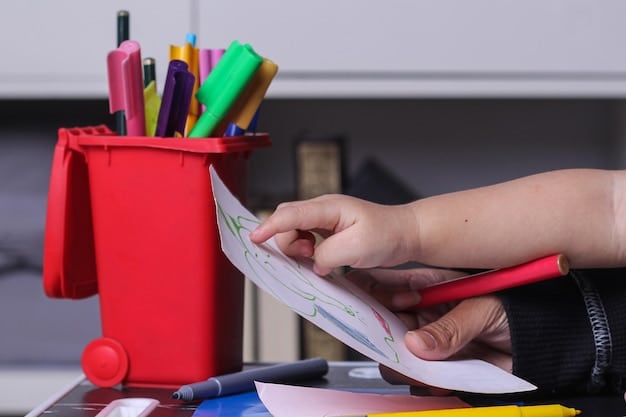Tax Credits for Teachers: Claim Up to $300 on Classroom Expenses in 2025

In 2025, teachers in the US can potentially claim up to $300 in tax credits for unreimbursed classroom expenses, playing a crucial role in offsetting educational costs.
Are you a teacher in the US looking to ease the financial burden of classroom expenses? The upcoming tax year in 2025 offers a chance for educators to claim tax credits for teachers, potentially deducting up to $300 for eligible unreimbursed classroom costs.
Understanding Tax Credits for Teachers: An Overview
Tax credits for teachers are designed to alleviate some of the financial strain educators face when purchasing classroom supplies and resources out-of-pocket. These credits provide a dollar-for-dollar reduction of your tax liability, which can make a significant difference in your overall tax bill. In recent years, understanding the specifics of these credits, including eligibility and deduction limits, has become increasingly important for teachers navigating their finances.
Staying informed about the latest updates and changes can maximize the benefits available to you as an educator. This guide explores the details of tax credits for teachers, focusing on the potential $300 deduction for classroom expenses in 2025. Keep reading to learn how to take advantage of this opportunity.

Who Qualifies for the Teacher Tax Credit?
Not all educators qualify for the teacher tax credit. There are specific requirements you must meet to be eligible. These requirements are designed to ensure that the credit benefits those who are directly involved in classroom instruction and incur unreimbursed expenses.
Understanding these criteria can help you determine whether you are eligible for the credit and what steps you need to take to ensure you can claim it when filing your taxes.
Eligibility Requirements
To qualify for the teacher tax credit, you generally must meet the following criteria:
- You must be a K-12 teacher, instructor, counselor, principal, or aide.
- You must work at least 900 hours during the school year.
- Your expenses must be unreimbursed, meaning you did not receive any reimbursement from your employer or another source.
- The expenses must be for eligible classroom-related items.
These requirements are designed to focus the tax credit on educators actively engaged in teaching and supporting students. Meeting these criteria is essential for successfully claiming the credit during tax season.
What Expenses Are Eligible?
The teacher tax credit covers a variety of classroom-related expenses, including:
- Books, supplies, and other classroom materials.
- Equipment, such as computers and software.
- Professional development courses related to your teaching field.
These eligible expenses help teachers create a better learning environment for their students and enhance their own professional skills. Keep detailed records of your expenses to make claiming the credit easier.
In summary, determining eligibility involves meeting specific criteria and ensuring that your expenses fall within the allowable categories. Understanding these aspects is key to maximizing the benefits of the teacher tax credit.
Maximizing Your $300 Deduction in 2025
To make the most of the $300 deduction available in 2025, it’s important to understand how to effectively track and document your expenses. Proper record-keeping can ensure that you meet all the requirements for claiming the credit and avoid any potential issues during tax season. Below are practical tips to maximize the tax credit for teachers in 2025.

Implementing these strategies can help you maximize your deduction and reduce your tax liability.
Tips for Tracking Expenses
Keeping track of your expenses can seem daunting, but with the right strategies, it can become a manageable task:
- Use a dedicated notebook or spreadsheet to record all classroom-related expenses.
- Keep all receipts and invoices organized in a file or folder.
- Consider using a mobile app to scan and store receipts electronically.
Documentation Requirements
Proper documentation is crucial for claiming the teacher tax credit. Make sure you have the following:
- Receipts for all purchases, showing the date, vendor, and amount.
- Invoices for professional development courses, including course descriptions and costs.
- Any other relevant documentation that supports your expenses.
Common Mistakes to Avoid
To avoid potential issues when claiming the credit, be aware of common mistakes:
- Failing to keep proper documentation of expenses.
- Claiming expenses that were reimbursed by your employer.
- Exceeding the deduction limit of $300.
By following these tips and avoiding common mistakes, you can maximize your $300 deduction and simplify the tax filing process.
Effectively tracking and documenting expenses is essential for maximizing your $300 deduction in 2025. By implementing these strategies and avoiding common mistakes, you can ensure a smooth and successful tax filing experience.
Navigating Tax Forms and Filing
Claiming the teacher tax credit involves understanding the relevant tax forms and properly reporting your eligible expenses. This section will guide you through the necessary steps to navigate the tax filing process and ensure you receive the credit you are entitled to.
Relevant Tax Forms
The primary form used to claim the teacher tax credit is Form 1040, U.S. Individual Income Tax Return. Additionally, you may need to use Schedule 1 (Form 1040), Additional Income and Adjustments to Income, to report the educator expenses.
Properly filling out these forms is essential for accurately reporting your expenses and claiming the credit.
Step-by-Step Filing Instructions
Follow these steps to claim the teacher tax credit when filing your taxes:
- Gather all necessary documentation, including receipts and invoices for eligible expenses.
- Complete Schedule 1 (Form 1040), listing your educator expenses.
- Transfer the total amount of educator expenses from Schedule 1 to Form 1040.
- Submit both forms with your tax return.
Following these steps will help you accurately claim the teacher tax credit and avoid any processing delays.
Filing taxes can often be confusing. Be sure to understand the tax credit forms completely for accurate claims.
Tips for Avoiding Errors
To ensure your tax return is processed smoothly, avoid these common errors:
- Double-check all calculations and amounts entered on the forms.
- Ensure all required documentation is included with your tax return.
- Review your completed forms carefully before submitting them.
By following these tips, you can minimize the risk of errors and ensure your tax return is processed accurately.
Knowing the tax process, forms and steps ensures the teacher tax credit is within reach for teachers.
The Impact of Teacher Tax Credits on Education
Teacher tax credits play a significant role in supporting educators and improving the overall quality of education. By providing financial relief for classroom expenses, these credits enable teachers to invest more in their students and create a better learning environment.
The positive impact of these credits extends beyond individual teachers, benefiting the entire education system.
Benefits for Teachers and Students
Teacher tax credits offer several key benefits:
- Reduced financial burden for teachers, allowing them to afford more classroom resources.
- Improved learning environment for students, with access to better materials and equipment.
- Increased job satisfaction for teachers, knowing their efforts are supported.
Long-Term Effects on the Education System
The long-term effects of teacher tax credits can be substantial:
- Higher teacher retention rates, reducing the costs associated with turnover.
- Increased investment in innovative teaching methods and technologies.
- Improved student outcomes, as a result of enhanced classroom resources and instruction.
Case Studies and Success Stories
Examples of how tax credits have positively impacted education:
- A teacher used the credit to purchase new books for her classroom library, improving reading comprehension among her students.
- A teacher invested in professional development courses, enhancing her teaching skills and leading to higher test scores.
Tax Credits are a great opportunity for both teachers and students for better educational results.
Teacher tax credits have a far-reaching impact on education, supporting teachers, improving learning environments, and enhancing student outcomes. By understanding and utilizing these credits, educators can make a significant difference in their classrooms and communities.
Future of Tax Credits for Teachers
The landscape of tax credits for teachers is subject to change, influenced by legislation and evolving educational needs. Staying informed about potential updates and future developments is crucial for educators to maximize the benefits available to them.
This section explores possible changes and advancements in teacher tax credits, along with resources for staying informed.
Potential Changes in Legislation
The future of tax credits for teachers may be shaped by changes in tax laws and regulations. Keep an eye on:
- Potential increases in the deduction limit.
- Expansion of eligible expenses to cover additional classroom-related costs.
- New legislation that could impact the availability or scope of the credit.
Keeping a close watch on these developments will help you stay ahead of the curve and make informed financial decisions.
Advancements in Education Funding
As education funding evolves, tax credits for teachers may adapt to address emerging needs:
- Targeted credits for teachers in under-resourced schools or high-need subject areas.
- Incentives for teachers who pursue advanced certifications or training.
- Tax benefits for educators who mentor new teachers or participate in school improvement initiatives.
Resources for Staying Informed
Stay up-to-date on the latest news and developments related to teacher tax credits by utilizing these resources:
- IRS website: Regularly check the IRS website for updates on tax laws and regulations.
- Professional organizations: Join professional organizations for educators, which often provide updates and resources on tax-related issues.
- Financial advisors: Consult with a financial advisor who specializes in tax planning for educators.
The future of tax credits for teachers holds potential for positive change and increased support for educators. Staying informed and proactive will help you navigate these developments and maximize the benefits available to you.
Staying up to date on information is key to claiming accurate tax amounts.
| Key Aspect | Brief Description |
|---|---|
| 📚 Eligibility | Must be a K-12 teacher working at least 900 hours. |
| 📝 Eligible Expenses | Includes books, supplies, equipment, and professional development. |
| 💰 Deduction Limit | Potential deduction of up to $300 in 2025. |
| 🧾 Documentation | Keep receipts and invoices for all expenses. |
Frequently Asked Questions
K-12 teachers, instructors, counselors, principals, or aides who work at least 900 hours during the school year are typically eligible.
Eligible expenses include books, supplies, equipment, and professional development courses related to your teaching field.
In 2025, you may be able to deduct up to $300 for eligible unreimbursed classroom expenses, helping to offset your costs.
You will report the educator expenses on Schedule 1 (Form 1040) and then transfer the total amount to Form 1040.
If you find errors in previous tax returns, file an amended return using Form 1040-X, Amended U.S. Individual Income Tax Return.
Conclusion
Understanding and leveraging the tax credits for teachers can significantly ease the financial burden faced by educators in the US. By staying informed, keeping meticulous records, and understanding the filing process, teachers can maximize their potential $300 deduction in 2025 and enhance the learning environment for their students.





